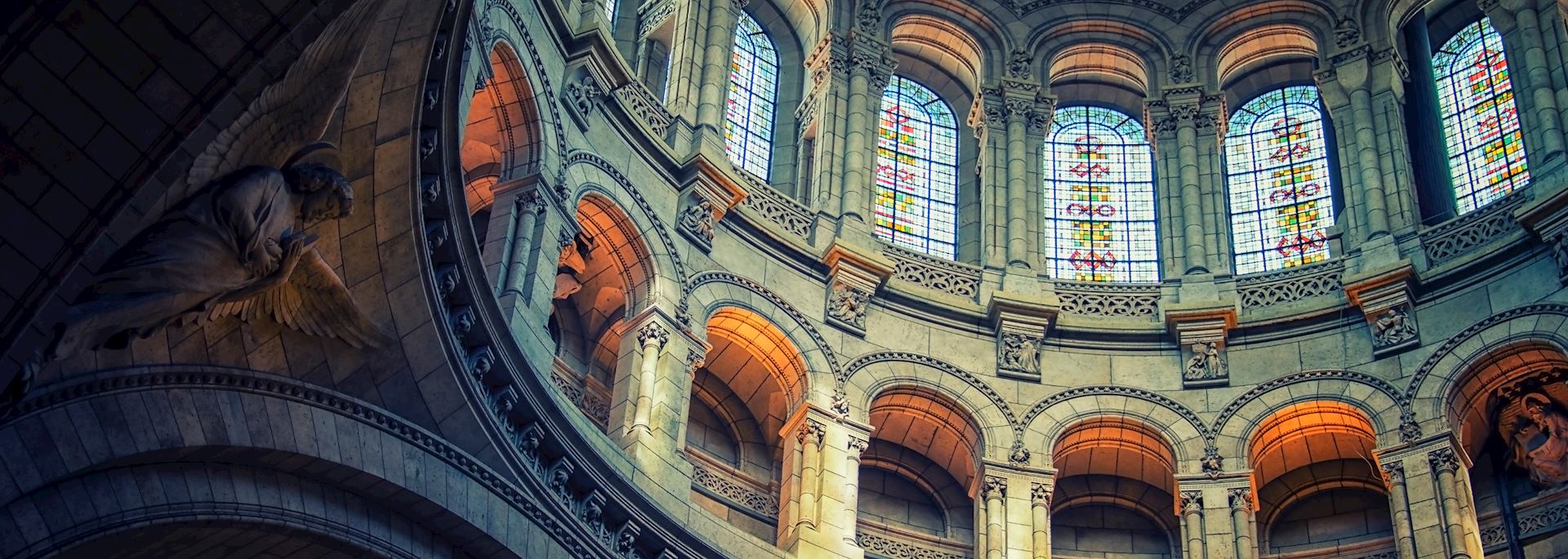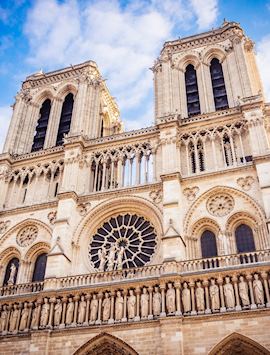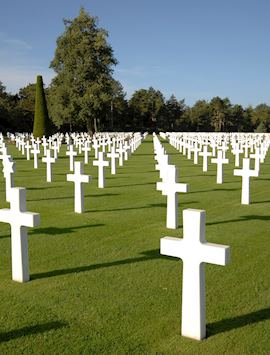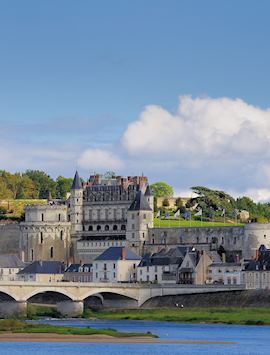By France specialist Leanne
For much of its history, Paris has regarded itself as the leading light of European culture, a belief reflected in the city’s institutions. Art and monumental architecture are integral to the very fabric of the city, especially along the axe historique (the historic axis). This line of monuments, museums and grand boulevards extends west from the heart of the city.
The route is dotted with dozens of the city’s most important sites, including the Eiffel Tower and the Louvre. I’ve seen these sights so many times that it can be hard to see them with fresh eyes. Whenever I visit, I like to seek out a new perspective, whether it’s with a private guide through the museum or a behind-the-scenes tour of the tower.
The Louvre
A thorough exploration of the Louvre is the work of a lifetime, but even a whirlwind tour of the highlights can seem like a daunting task. The displayed collection is breathtaking in its scope and depth, with more than 35,000 pieces that range from anonymous Etruscan vases to da Vinci’s Mona Lisa.
After visiting several times and becoming overwhelmed and distracted, I took a tour with a private guide and it made all the difference.

Sophisticated, knowledgeable and passionate, David has devoted his life to studying the Louvre and its collections. He earned his advanced degree in art history at the École du Louvre and leads guided tours of the museum tailored to his clients’ particular interests. Thanks to his intimate familiarity with the rambling building, he can divert you past the crowds and duck through secret shortcuts to ensure that you see everything you’d like to, without feeling rushed or overcome.
Of course, there’s so much to see. Renaissance painters like da Vinci, Raphael, Titian, Botticini, Botticelli and Michelangelo all have important pieces here, which hang alongside Dutch artists like Rembrandt and Vermeer, and French masters like Ingres, Delacroix and Géricault.
I’m particularly fond of La Liberté guidant le people, Delacroix’s painting that depicts a bare-breasted Liberty waving the Tricolore flag as she leads the people over a barricade. Its undaunted spirit depicting the country’s ideals of equality and liberty always stirs my American heart.
The antiquities rooms can provide a little relief if you’re overcome from viewing some of the world’s most transcendent paintings. David directed me to the best-known classical pieces, including the massive finger-shaped basalt stele that’s inscribed with the Code of Hammurabi and the armless Venus de Milo, but there were countless others.
The building itself is impressive. Consisting of three wings spread over four floors, the stately former royal palace began life as a fortress — you can visit its original foundations and even the dungeon in the basement. I M Pei’s starkly modern steel-and-glass Grande Pyramide at the entrance stands in shocking contrast to the ornate grandeur of the palace’s façade.
I also like to visit the gilded opulence of Napoleon III’s apartments, located on the first floor of the Richelieu wing. The rooms are an exercise in excess, and walking through them is a little like being inside a Fabergé egg. Everything is gilded or encrusted in jewels or hung with crystals.
The Louvre is arguably the most visited museum in the world, and the crowds can be thick around the most popular pieces. Thoughtful timing can avoid some of the worst of the hoards. If you don’t want to go early in the morning, you might consider an evening visit — the museum is open until 9:45pm on Wednesdays.
Musée Rodin
Across the river but a world away, the Musée Rodin is a smaller, quieter museum that’s an antidote to the Louvre’s overwhelming magnificence. It’s possible to see the entire collection instead of having to cherry pick. As a bonus, there are far fewer visitors and I’ve never felt jostled or crowded here.
Tucked behind a high limestone wall in the 7th arrondissement, the museum is located inside the Hôtel Biron. The grand 1730 hôtel particulier (an elegant urban mansion) was where Rodin lived and worked for much of his later career. A recent restoration, finished in 2015, has returned both the building and the extensive grounds to their earlier glory.

The museum’s rose garden is a particularly peaceful spot, a floral oasis inside the heart of the city. Over the hedges, you can just make out the gold dome of nearby Les Invalides. I found it deeply soothing to stand in the garden and contemplate a single sculpture, Rodin’s weighty The Thinker, in relative solitude.
In addition to The Thinker, many of Rodin’s other well-known works are here, including his sensuous ode to love, The Kiss, and his monumental depiction of Dante’s Inferno, The Gates of Hell.
Most people know Rodin primarily as a sculptor, but he was also an avid collector. The museum houses the thousands of works he gathered during his travels, including sculptures, drawings, photographs, paintings and objets d’art. There’s an entire room devoted to the works of Camille Claudel, Rodin’s lover and colleague, and you can also find paintings by Van Gogh, Renoir and Monet.
I like to plan my trip to the Musée Rodin for late afternoon, when there are even fewer people in attendance but I can still appreciate the sculptures in the warm glow of the sun’s natural light.
Musée d’Orsay
One of the city’s newest museums, the Musée d’Orsay opened in 1986, created by the French government as a way to bridge the gap between the Louvre and the Musée National d'Art Moderne. The airy building was once a Beaux-Arts railway station and provides a fitting display space for the museum’s collection of mostly French works created between 1848 and 1914.

The museum houses the largest assemblage of Impressionist and Post-Impressionist art pieces in the world, including paintings, sculptures, furniture and photographs. As a fan of the period, I’m always thrilled by the list of artists whose works are represented here: Monet, Manet, Cézanne, Seurat, Van Gogh and Renoir, among hundreds of others.
For years, Renoir’s Danse à la campagne was the painting I liked the best, but on my most recent visit I fell in love with his Nue au soleil. Something about the play of dappled light over the pale nude torso of the subject kept drawing me back to the painting. My guide, Céline, explained that Renoir had been savaged by critics over the work, who’d declared that his use of different hues made his subject look like a mottled corpse. Understanding how radical Renoir’s technique was gave me a deeper appreciation of both the piece and the period.
The artwork isn’t the only thing to admire at the museum. There’s a rooftop terrace, open at irregular hours, with a view of the river and Jardin des Tuileries on the far bank. You can also get a unique view of the Louvre framed by the bold black lines of the building’s original clock face.
Eiffel Tower
Despite its familiarity, seeing the Eiffel Tower for the first time was still a surprise. It wasn’t until I was standing under the soaring arches that join the wide feet and gazing straight up that I could truly comprehend its scale.
The sheer size is all the more shocking when you know the history. Engineer Gustave Eiffel built it as the temporary entrance to the Exposition Universelle of 1889. The curved lattice design was quite controversial at the time of its construction — author Guy de Maupassant is said to have eaten lunch at the tower every day because it was the one place in the city where he didn’t have to look at it. However, its popularity has ensured its longevity.
Indeed, the tower continues to draw in more than seven million visitors a year. Getting to the top can be a bit of an ordeal, starting with a long wait and then shuffling through security before cramming into an elevator with other visitors. To avoid all this, I suggest a behind-the-scenes tour.

The shared tour starts under a statue of Gustav Eiffel himself before heading beneath the Champs de Mars (the massive and formal greenspace adjacent to the tower) to the once-secret military bunker under the tower. Once the hub of vital military communications using the tower as a massive antenna, it’s now a part of the Michelin-starred restaurant above.
The tour continued on to explore the mechanisms that run the tower’s eight elevators. The tree-trunk-thick cables and huge pulleys, as well as the hydraulic counterweights, date back to the original construction.
From there, we took the elevator up to a gallery on the second floor. Though the view was partially obstructed by the tower, it was a pleasure to see the city without the press of other visitors on a secluded viewing platform.
Though much is made of the view from the tower, I prefer to look at the tower, especially at night. The whole structure is lit up, a spire of white light piercing the sky, and for a few minutes every hour it sparkles. I’d spend part of an evening with a bottle of wine on the Champ de Mars to watch the glittering spectacle.
Notre-Dame Cathedral
Located on the Île de la Cité, Notre-Dame Cathedral is the literal and spiritual heart of Paris. Literal because it’s here you find Point Zéro, an unassuming brass star embedded in the stones of the plaza in front of the cathedral. All points in France are measured from that spot, and you’ll often find it covered with coins, left for luck by visitors.

The cathedral is a masterpiece of Gothic architecture, carefully balancing all its myriad elements into a surprisingly harmonious whole of flying buttresses, intricate rose windows and the trademark gargoyles. It’s so massive that it can be hard to take in, but there’s a good view from the small garden in the back, called Le Square Jean XXIII.
On the outside, I’d pick out the three front entrances, which are decorated with relief carvings that depict stories from the Bible. The high-relief scenes helped to educate the populace in the days before widespread literacy.
Inside, I’m always drawn to the three massive rose windows. When the sun streams through, they bathe the interior in a kaleidoscope of multihued light.
The climb to the bell tower is steep, narrow and long, but at the top you come face to face with the cathedral’s photogenic gargoyles and a view that takes in the river, the island and the Sacré-Coeur.
Sacré-Coeur Basilica
High on Montmartre, the elongated white domes of the Sacré-Coeur gleam in the sunlight, visible from almost anywhere in Paris. The Byzantine-inspired design is a stark contrast to the Gothic style that dominates much of the city’s sacred architecture.

The basilica was begun in 1875 as a penance for whatever sins France may have committed that caused it to lose the Franco-Prussian War. It’s still an active church and pilgrimage site, and prayers for humanity have been said in the nave continuously since 1885.
At the top of the dome, you can see as far as 30 km (19 miles) on a clear day. But the view from the front steps is nearly as good and doesn’t require climbing up 300 spiral stairs.
Montmartre’s bohemian reputation is on full display here, with musicians performing, painters with their easels, and con artists trying to sell things to the unwary. The visitors that the area attracts seem to be a little quirky, too — I once watched a couple, dressed in matching outfits, run up and down the stairs for an hour, pursuing some inscrutable goal.
Arc de Triomphe
Designed with Napoleon’s usual humility and reserve, the massive Arc de Triomphe is the classically styled lynchpin of the Axe Historique. The intricately sculpted arch both celebrates the emperor’s victory over the Austrians at Austerlitz and serves as a memorial to all the French soldiers who have fought in any war.

It stands in the heart of Place Charles de Gaulle, a roundabout at the junction of 12 main avenues. Locals call the roundabout the Étoile (star), thanks to its shape, and the traffic here is both fast and dangerous. You can avoid having to cross it by taking the underground pedestrian passage from the Champs-Élysées, which brings you safely under the traffic to the base of the arch.
The top of the triumphal arch offers one of the best views of the Eiffel Tower that I’ve discovered so far, as well as panoramic views of the city down each of the wide avenues.
The exterior of the arch is covered in high-relief panels depicting important scenes from the French Revolution and the Napoleonic era. Inside, the arch is inscribed with the names of French military leaders. Underneath, you’ll find an eternal flame at the Tomb of the Unknown Soldier, a memorial to the millions of French soldiers who fell during World War I.
Start planning your trip to France
Start thinking about your experience. These itineraries are simply suggestions for how you could enjoy some of the same experiences as our specialists. They're just for inspiration, because your trip will be created around your particular tastes.
View All Tours in France




